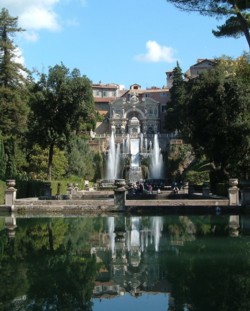Villa d’Este was built in 1550 for Cardinal Ippolito d’Este, the son of Lucrezia Borgia and Alfonso d’Este. It occupies a stretch of hillside below the town of Tivoli, with spectacular views over the plain towards Rome. Built around an earlier monastery, the building is lavishly decorated with frescoes, reliefs and internal fountains. The most striking part of the Villa d’Este, however, is its garden; a terraced extravaganza of shady trees and showstopping fountains. Subsequent cardinal-owners added to the gardens, which after a period of decay have been restored in recent decades.
The garden is designated a UNESCO World Heritage Site in recognition of its significance in the history of garden design, and its fountains are famous worldwide. Film fans will recognise many of the garden’s features in the opening sequence of Three Coins in the Fountain.
The current unassuming entrance is set in the back of the building, and it’s only by descending a flight of stairs and passing through ornately-decorated (but unfurnished) chambers that the visitor reaches the front of the building. Once, the main approach would have brought visitors before this grand facade; now it comes as a sudden surprise.
A number of paths and steps lead down through the formal slopes to panoramas and fountains. The Rometta is a tribute to Rome; a water feature which incorporates recreations of the city’s monuments; the Bicchierone fountain is a later addition by Bernini; the Ovato is an atmospheric fountain backed by a nymphaeum. Other highlights include the Fountain of the Dragons, a many-breasted sculpture of Diana, the long path of the Hundred Fountains and the massive cascade below the Water Organ.

A number of the novelty fountains are activated during the day, with times displayed at the entrance. At the Fountain of the Owl, birds warble until a model owl appears to scare them into silence, while the Water Organ periodically offers musical entertainment to visitors. Notice boards and plans dotted around the garden offer historical information about the fountains, in English as well as Italian.
A reasonable self-service caffeteria on the terrace level offers tourists the chance to enjoy a meal or refreshments while enjoying the views over the gardens.
The Villa comes into its own on a hot summer’s day, when visitors fleeing from the heat of Rome will appreciate the cooling combination of location, shade and cold running water. Tivoli is easy to reach from Rome, and the Villa d’Este is a mere two-minutes’ walk from the bus stop (follow the chain of souvenir stalls). The gardens can be visited as a half-day trip, although many visitors will prefer to take their time, and enjoy a meal in the town or on the garden terrace overlooking the hot plains.
On this site
Tivoli travel and tourist information
Useful external links
Lazio destinations
- About the Lazio region
- Anzio
- Bracciano
- Calcata
- Castel Gandolfo
- Castelli Romani
- Cerveteri
- Formia
- Frascati
- Gaeta
- Palestrina
- Pontine islands
- Ponza
- Rome
- Sperlonga
- Terracina
- Tivoli
- Ventotene
- Viterbo
